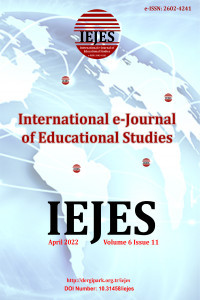Assessment of Mobile Phone Usage and Loneliness Levels of Faculty of Sports Sciences Students
Sports, student, cell phone, loneliness
Assessment of Mobile Phone Usage and Loneliness Levels of Faculty of Sports Sciences Students
Sports, student, cell phone, loneliness,
___
- Akgül-Bozgeyik, B. (2019). An investigation of the relationships between teachers’ early maladaptive schemas, interpersonal relationship styles and loneliness. Master Thesis. Gaziantep: Gaziantep University.
- Alakurt, T. & Yılmaz, B. (2021). Teachers’ views on the use of mobile phones in schools. Journal of Computer and Education Research, 9 (18), 575-597. https://doi.org/10.18009/jcer.901358
- Boumosleh, J., & Jaalouk, D. (2017). Depression, anxiety, and smartphone addiction in university students-a cross sectional study. Plos One, 12(8), E0182239.
- Goodall, W., Fishman, T. D., Bornstein, J., & Bonthron, B. (2017). The rise of mobility-as- a-service. Deloitte Review, 20, 111–130.
- Emanuel, R., Bell, R., Cotton, C., Craig, J., Drummond, D., Gibson, S., ... & Williams, A. (2015). The truth about smartphone addiction. College Student Journal, 49(2), 291-299
- Erboy, E. (2010). Factors affecting computer game addiction of primary school 4th and 5th grade students. Master Thesis, Adnan Menderes University, Aydın.
- Hazar, Z., Demir, G. T., Namlı, S., & Türkeli, A. (2017). Examining the relationship between secondary school students’ digital game addiction and physical activity levels. Journal of Physical Education and Sport Sciences, 11(3), 320-332.
- Horzum, M. B. (2011). Examining the computer game addiction levels of primary school students according to various variables. Education and Science, 36(159), 56-68.
- Işık, A.D. (2015). Features of mobile devices and its implications into education: A literature review. Journal of Computer and Education Research, 3 (6), 188-198.
- Izgar, H. (2009). An investigation of depression and loneliness among school principals. Educational Sciences in Theory and Practice, 247-258.
- Karasar, N. (2012). Scientific research method. Ankara: Nobel Publishing.
- Lee, Y.-K., Chang, C.-T., Lin, Y., & Cheng, Z.-H. (2014). The dark side of smart phone usage: Psychological traits, compulsive behavior and technostress. Computers in Human Behavior, 31, 373-383.
- Poushter, J. (2016). Smartphone ownership and internet usagecontinuesto climb in emerging economies. Pew Research Center, 22, 1-44
- Samaha, M., & Hawi, N. S. (2016). Relationships among smartphone addiction, stress, academic performance, and satisfaction with life. Computers in Human Behavior, 57, 321-325.
- Sezer, S.Y. & Çelikel, B.E. (2021). Investigation of the leather time management of football players in Elazig province during the covid 19 process, Spor Eğitim Dergisi, 5 (3), 135-142.
- Tansu, A. (2022). The effectiveness of cognitive behavioral based psychoeducation in university students with smartphone addiction (Order No. 30411073). Available from ProQuest Dissertations&Theses Global. (2812066013). Retrieved from https://www.proquest.com/dissertations-theses/smart-phone-addicted-university/docview/2812066013/se-2
- Tel, M. (2021). Investigation of athletes’ habits of playing digital game in the pandemic process. Pakistan Journal of Medical and Health Sciences, 15(12), 3630-3638.
- Tel, M., & Erdogan, R. (2015). Investigation of doctors’ participation in leisure activity. International Journal of Science Culture and Sport, 3(4), 383-395.
- Townsend, A. M. (2000). Life in the real time city: Mobile telephones and urban metabolism. Journal of Urban Technology, 7, 85-104.
- Turhan F. H. & Canpolat B., (2023). Examining the purposes of facebook use of some football club fans. İnönü Üniversitesi, Beden Eğitimi ve Spor Bilimleri Dergisi, 10(1), 1-12.
- Van Deursen, A. J. A. M., Bolle, C. L., Hegner, S. M., Hegner, S., & Kommers, P. A. M. (2015). Modelling habitual and addictive smart phone behavior: The role of smart phone usa getypes, emotional intelligence, socialstress, selfregulation, age, and gender. Computers in Human Behavior, 45, 411-420.
- Başlangıç: 2017
- Yayıncı: Tamer KUTLUCA
Examination of Foreign Students’ Anxiety in Learning Turkish in Terms of Various Variables
Implications from a Modelling based Flipped Mathematics Course
Deniz ÖZEN ÜNAL, Ersen YAZICI, Taner ARABACIOGLU
Examination of Fair Play Approaches of High School Students who Participate in School Sports and not
Development of Turkish Reading Anxiety Scale
Suleyman KASAP, Mahmut AYAZ, Mehmet Sena ATAŞ
